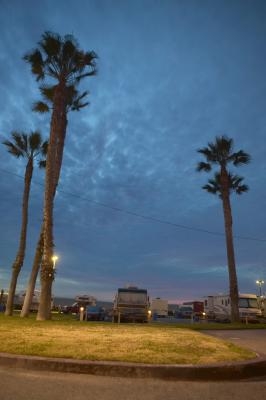
An RV isn't like most other vehicles; it's more akin to a rolling house than anything else. This makes painting one an entirely different endeavor than painting the average automobile, sending the costs of bodywork and materials skyrocketing. Since time is money, one of the best ways to reduce overall cost is to reduce the amount of preparation and spray time. Things get even more complicated when you consider the fact that consumers can't even acquire automotive-grade, volatile, organic-compound-containing paints any longer. Fortunately, the DIY solution to your problems may be a bit cheaper and closer at hand than you may think.
Mask anything on the RV that you don't want painted. The approved method involves removing the emblems, applying masking tape and masking paper, then trimming the tape around the trim and lights with a razor blade. However, you can save quite a bit of time by covering the windows and lights with packing cellophane, pushing it into the cracks with a plastic knife and then trimming it with a razor.
Put the widest possible orifice tip on the sandblasting gun, then turn the compressor pressure down to about 90 psi. Hold the gun about two feet back from your RV paint and test it in an inconspicuous place. Your goal is just to knock the gloss off your existing RV paint, not to remove it. If in doubt, increase your distance, reduce air pressure and spend a little more time on the panel.
Soda-blast the entire RV, from top to bottom, until there isn't a bit of gloss left. Be very careful around the edges of the tape or plastic wrap. When you approach the edges of the wrap, angle the gun so that it's blowing slightly across the mask and away from the edge. The goal is to first avoid blasting the mask -- especially if it's plastic -- and secondly to avoid pushing the air and blasting material under the edges of the mask.
Thoroughly spray the vehicle down with a water hose to dissolve the baking soda, and be careful around the masks. Allow the RV to dry completely, preferably overnight. It is crucial that the RV be completely dry before painting. You can accelerate the process by spraying compressed air into panel gaps. After drying, re-check the masking to make sure that the edges are still secure, and repair with masking tape, as need be.
Load the HVLP gun up with high-performance protective enamel. Also known as "trailer paint" and available at any hardware store, these coatings are specifically designed for industrial applications where the paint must go over bare metal. This enamel is tough, corrosion-resistant and offers about 95 percent of the gloss of a dedicated car paint. Lighter colors, such as white and beige, will look best, since they'll hide surface imperfections and inconsistencies in the paint better than darker colors.
Paint the entire RV, from end to end, in three light coats. Work around the RV in a clockwise direction, covering it from top to bottom, in sections; the paint should have set up enough for a second coat by the time you get back around to where you started. Different paints cure at different rates, depending upon the temperature and humidity, so consult the can label for drying time recommendations.
Wait for the paint to get dry to the touch, then begin carefully removing the masks. Pull the masks back against themselves, very slowly, to avoid lifting the paint. Once you have them all off, dip a small artist's paintbrush in the paint and touch up any areas you might have missed.